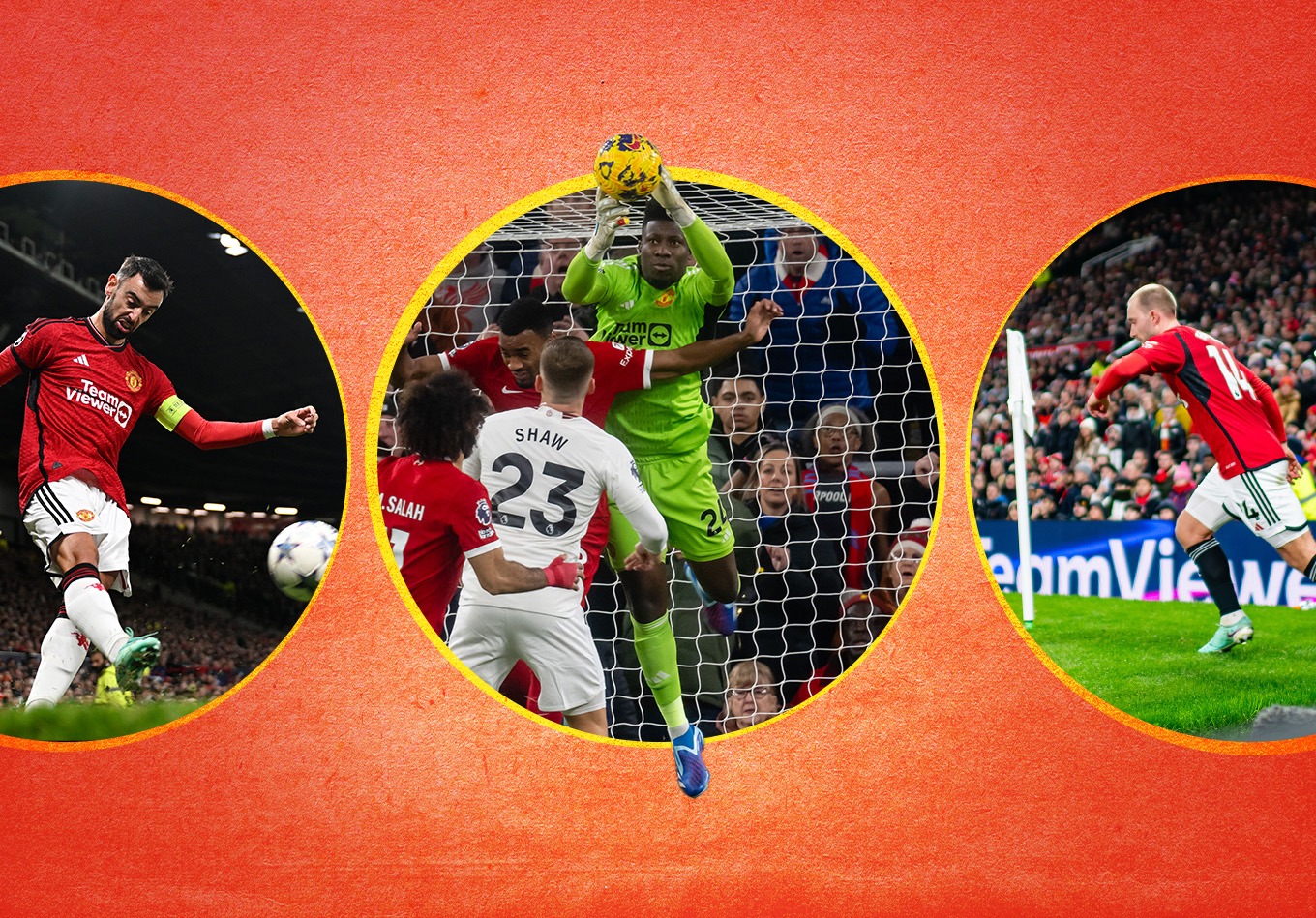Manchester United have received plenty of attention recently for how they defend and attack corners. We analysed the data to see if the criticism is justified or not.
With Sir Jim Ratcliffe buying a significant stake in Manchester United and beginning to overhaul the club off the pitch, it would seem that at long last the Glazer era is coming to an end, but otherwise there have been few positives emanating from Old Trafford this season.
After appearing to make progress on the pitch last term, in 2023-24 it feels as though they’ve taken two steps back. In pre-season, we identified several areas for improvement; while it’s difficult to conclude they’ve massively improved in any way since, one of the aspects of their game we highlighted back then was set-pieces.
United’s record at corners was unimpressive in 2022-23, both attacking and defending, and they continue to be questioned about their methods in this area, particularly recently.
In the 2-2 home draw with Tottenham earlier this month, United looked especially susceptible at corners. Not only was Spurs’ first goal, a Richarlison header, from such a scenario, but they went extremely close from two other similar situations as Diego Dalot cleared off the line and Cristian Romero headed against the crossbar.
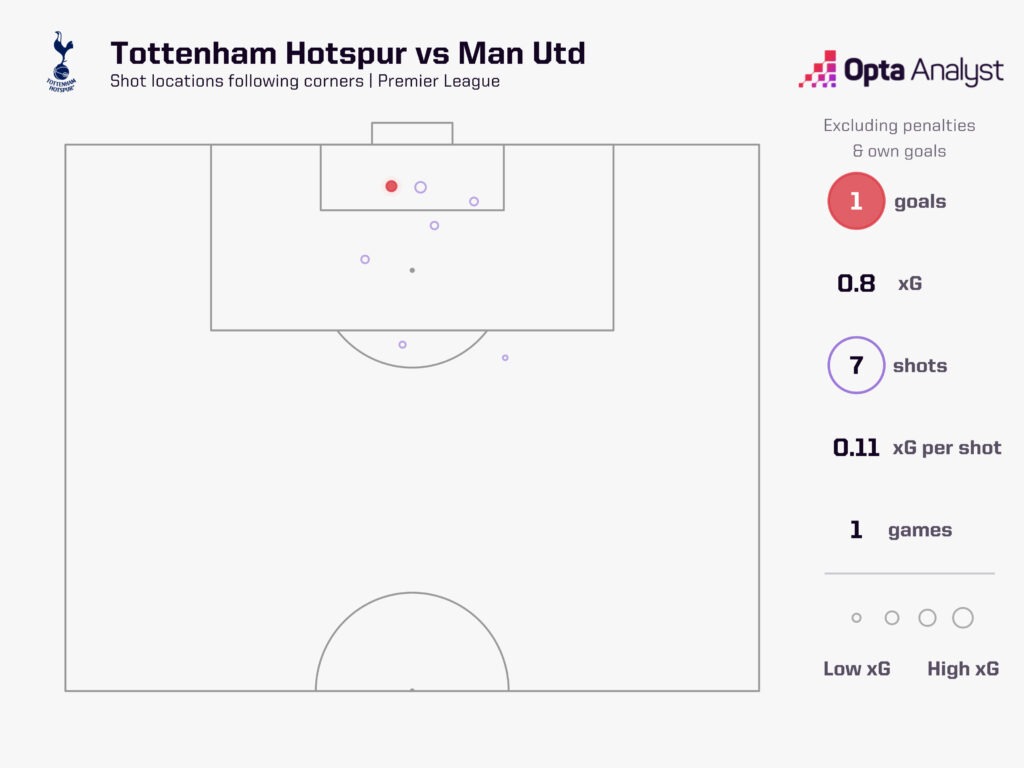
After the game, which was Ratcliffe’s first at Old Trafford since agreeing to buy a 25% stake the club in December, Erik ten Hag didn’t hide his frustration at how feeble United were defensively when facing corners.
Asked what conclusions Ratcliffe might have come to during the match, Ten Hag told Sky Sports: “He will have seen a team fighting for each other and trying to get a win. He has seen two great goals on our side and also what he should have noticed is we should be more man when we have to defend corners. We should defend set-plays better. You have to grow up and be more physical, head the ball away. That [goal] shouldn’t happen.”
It isn’t just corners; set-pieces in general have accounted for 23% of United’s overall expected goals against (xGA) in the Premier League this season, with only Liverpool (25%) seeing a greater proportion of their xGA attributed to set-plays.
This supports the perception among United fans that they are simply poor at defending corners, so how bad is it really?
At Opta Analyst, we’re lucky enough to have a treasure trove of immensely in-depth corner data that no one else has. Looking at one of the more rudimentary metrics available certainly doesn’t reflect well on United; just over half of the corners they’ve faced this season (50.4%) have been met first by one of their opponents, with only Bournemouth (54%) and Everton (59.5%) doing worse in this respect.
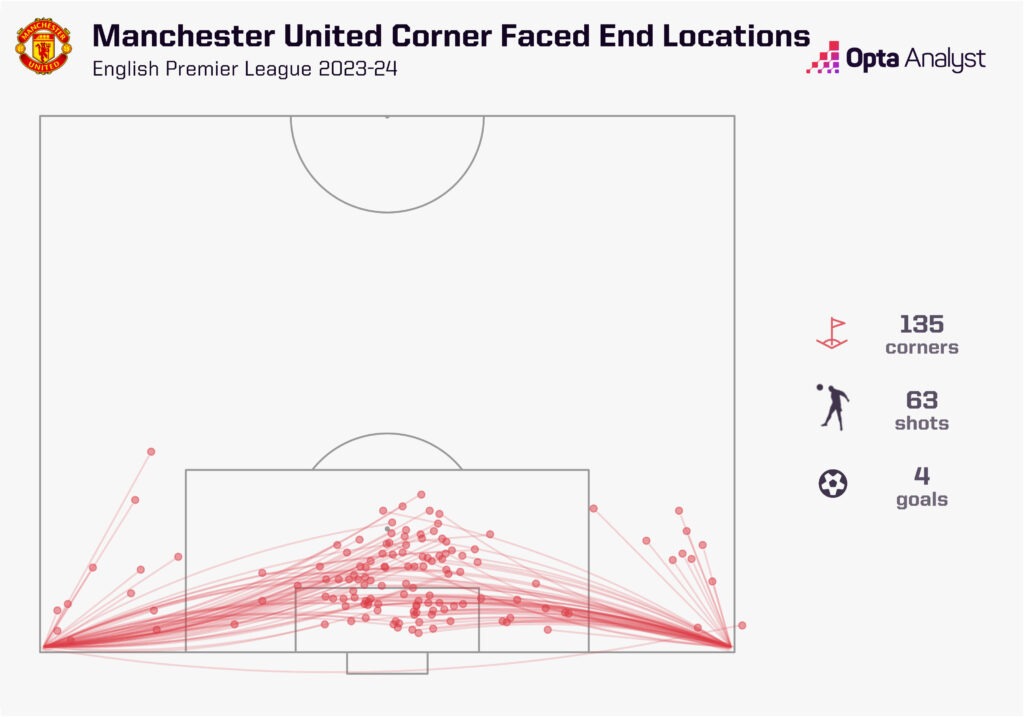
Obviously, you can only read so much into this isolated statistic, but it’s not a great start, is it? It stands to reason that you might be more likely to concede from a corner if your opponents get to the delivery first.
Similarly, 40.7% of the corners United have conceded also led to at least one shot by their opponents; Chelsea (44.9%), Luton Town (44.1%) and Tottenham (42.7%) are the only clubs less effective at preventing attempts at corners.
Those shots against United have been worth 5.7 xG, the second-worst total in the Premier League ahead of only rock-bottom Sheffield United (6.7 xG).
But we have to go back to the source and look at the bigger picture. United have conceded 135 corners in the Premier League this term, which is the third most behind Sheffield United (146) and Spurs (143). While the point remains regarding a high proportion of corners faced leading to shots, when you consider many other metrics in the context of United simply conceding a lot of set-plays, the numbers aren’t quite as damning.
For instance, they’ve let in four goals that are deemed to have occurred in the passage of play following a corner. That equates to 2.96% of corners faced, with only five clubs seeing a smaller proportion of corners conceded lead to a goal concession.
Arsenal have the poorest record in the Premier League in this respect. They’ve conceded the fewest corners (58) but five have resulted in a goal for their opponents; that’s 8.6%, putting them comfortably clear of every other team (Brighton are next on 6.3%).
We can also break down the quality of chances teams have faced from corners a little further. So, while United’s 5.7 xGA is the second worst, the average xG value of those attempts is 0.091, putting them around mid-table in the Premier League.
So, much of it simply comes down to the sheer number of corners they concede. Now, obviously having a better and more reliable defensive structure would help because in all likelihood they’d face fewer shots and therefore fewer shots that lead to a corner; their 317 attempts faced (including those blocked) is the fourth-most in the Premier League this term.
After all, if the chances you concede at corners are roughly of the average quality, then facing lots of them is potentially asking for trouble.
Nevertheless, while United’s record defending corners might not be as bad as the coverage of them recently has suggested (or just accentuated by the Tottenham performance), there are clearly still some areas for concern, mostly around first contact.
David de Gea had rarely been convincing when coming for crosses or corners during his Manchester United career, so undoubtedly many United fans were hoping his eventual replacement would bring a little more reliability in that respect. That hasn’t yet come to pass with André Onana, whose unconvincing start to life at Old Trafford has contributed to him becoming something of a target for opponents.
Teams crowding a goalkeeper isn’t anything new, nor is it a tactic that’s in any way unique to Onana, but teams facing United managed to get the first contact on 33.9% of inswinging corners, second only to West Ham (37.3%), which doesn’t reflect particularly well on either Onana’s command of his area nor United’s aerial ability in general.
That’s also an issue seemingly impacting United at the other end of the pitch. Despite taking the fourth-most corners (134), United are one of only five teams yet to score a goal from their first contact at a corner this season.
They have at least scored a couple of times in the passage of play following a corner, but generally speaking, the outlook is bleaker in terms of their productivity at offensive corners than it is defensive corners.
While Arsenal have the best ratio of corners to goals from corners, scoring once every 16.4 corners on average, United’s record is among the worst, netting one goal for every 67 corners. That sees them rank 15th.
Those two goals came from 3.1 xG, which obviously suggests an element of misfortune or wastefulness. But when we consider their xG output in the context of the total shots they’ve been presented with at corner situations, United’s stunted set-piece threat is really highlighted.
The shots they’ve had at corners have an average xG value of just 0.06, which is the lowest of all 20 Premier League teams this season – it’s a damning summary of their work at corners, and arguably indicative of a lack of aerial prowess through the team, particularly if Harry Maguire and Casemiro aren’t playing.
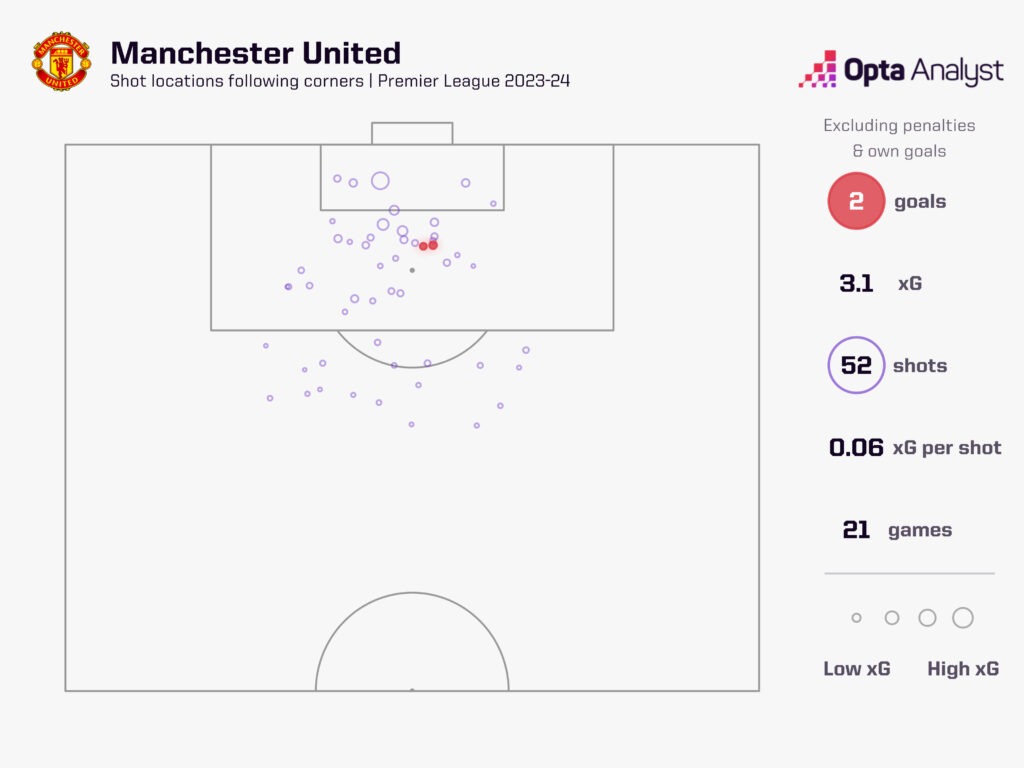
Maybe none of this is especially surprising, then. United aren’t a dominant, physical side and they’ve recorded more headed shots (34) – and goals (three) – than just four teams in 2023-24, and yet their proportion of outswinging corners (from crosses), which bend away from the danger zone, is among the highest partly due to how much time Luke Shaw has been out injured.
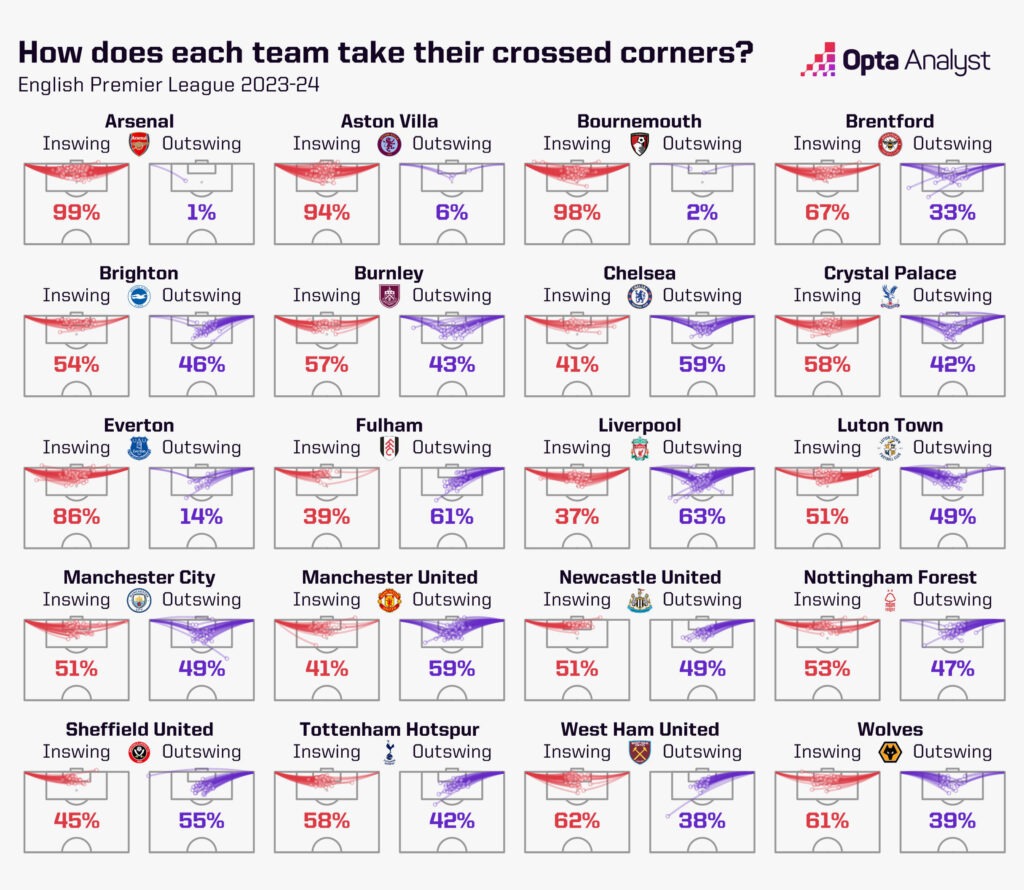
One area we can highlight as a positive is short corners. United have managed to record at least one shot following 37% of their short-corner routines, which only four teams (minimum 10 short corners) can better. That’s also a greater proportion than United’s crossed corners leading to a shot (34.7%), suggesting they might do well to focus on more shorter, more subtle routines.
But, at the same time, that feels like straw-clutching somewhat. The fact of the matter is, United’s output at attacking corners is among the poorest in the Premier League at the moment; considering they win more corners than almost every other team, this feels like a huge waste.
Sure, their record when defending corners might not be as bad as you thought, but when considered in conjunction with how ineffective they are at attacking them, United’s room for improvement at set-pieces becomes abundantly clear.
Enjoy this? Subscribe to our new football newsletter to receive exclusive weekly content. You should also follow our social accounts over on X, Instagram, TikTok and Facebook.
